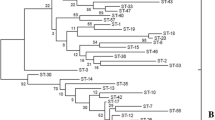Abstract
The population of bacteria ofSelenomonas ruminantium species in the rumen of fallow-deer was analyzed using endonucleolytic activity assay and plasmid profiles. This analysis indicated a high diversity within the population ofS. ruminantium. At least 12 different restriction profiles, indicating the presence of the different specificity nucleases, have been observed. Site-specific endonucleases were detected in 17 out of 45 strains tested. In other strains a various level of nonspecific activity was detected. Plasmid DNAs ranging in size from 0.9 to more than 25 kbp were detected in 60% of strains analyzed. No or little correlation was observed between the endonuclease activity and the plasmid content. The presence of different specificity endonucleases, as well as differences of plasmid profiles of isolates possessing identical specific activity indicate that the population ofS. ruminantium in the rumen of an individual animal consists of at least 10 different clones.
Similar content being viewed by others
References
Avgustin G., Wright F., Flint H.J.: Genetic diversity and phylogenetic relationships among strains ofPrevotella (Bacteroides) ruminicola from the rumen.Int.J.Syst.Bacteriol.44, 246–255 (1994).
Birnboim H.C., Doly J.: A rapid alkaline lysis procedure for screening recombinant plasmid DNA.Nucl.Acids Res.7, 1515–1523 (1979).
Bryant M.P.: Selenomonas, pp. 650–653 inBergey’s Manual of Systematic Bacteriology, Vol. 1 (N.R. Krieg, J.G. Holt, Eds). Williams & Wilkins, Baltimore-London 1984.
Clarke R.T.J., Bauchop T.:Microbial Ecology of the Gut. Academic Press, New York 1977.
Flint H.J., Bisset J.: Genetic diversity inSelenomonas ruminantium isolated from the rumen.FEMS Microbiol.Ecol.73, 351–360 (1990).
Holdeman L.V., Cato E.P., Moore W.E.C.:Anaerobe Laboratory Manual. Institute and State University, Blackburg (Virginia) 1971.
Hudman J.F., Gregg K.: Genetic diversity among strains of bacteria from the rumen.Curr.Microbiol.19, 313–318 (1989).
Macrina F.L., Kopecko D.J., Jones K.R., Ayers D.J., Mccowen S.M.: A multiple plasmid-containingEscherichia coli strain: convenient source of size reference plasmid molecules.Plasmid1, 417–420 (1978).
Mannarelli B.M.: Deoxyribonucleic acid relatedness among strains of the speciesButyrivibrio fibrisolvens.Int.J.Syst.Bacteriol.38, 340–347 (1988).
Maniatis T., Fritsch E.F., Sambrook J.:Molecular Cloning: A Laboratory Manual. Cold Spring Harbor Laboratory Cold Spring Harbor (New York) 1982.
Martin S.A., Dean R.G.: Characterization of a plasmid from ruminal bacteriaSelenomonas ruminantium.Appl.Environ. Microbiol.55, 3035–3038 (1989).
Pristaš P., Vanat I., Godany A., Javorský P.: Restriction endonucleases fromSelenomonas ruminantium which recognize and cleave 5′-AT/TAAT-3′.Arch.Microbiol.161, 439–441 (1994).
Pristaš P., Vanat I., Javorský P.: Isolation and characterization of a new restriction endonuclease,Sru30DI, fromSelenomonas ruminantium.Gene158, 139–140 (1995).
Tiwari A.D., Bryant M.P., Wolfe R.S.: Simple method for isolation ofSelenomonas ruminantium and some nutritional characteristics of the species.J.Dairy Sci.52, 2054–2056 (1969).
Vanat I., Pristaš P., Rybošová E., Godány A., Javorský P.:SruI restriction endonuclease fromSelenomonas ruminantium.FEMS Microbiol.Lett.113, 129–132 (1993).
Zhang N., Graeme T., Attwood R.A., Lockington A., Brooker J.D.: Genetic diversity in ruminal isolates ofSelenomonas ruminantium.Curr.Microbiol.22, 279–284 (1991).
Zhang N., Brooker J.D.: Characterization, sequence and replication of a small cryptic plasmid fromSelenomonas ruminantium.Plasmid29, 125–131 (1993).
Author information
Authors and Affiliations
Additional information
This work was supported byGrant Agency VEGA 3007/96.
Rights and permissions
About this article
Cite this article
Pristaš, P., Vanat, I. & Javorský, P. Variability of endonucleolytic activity indicates high genetic diversity within the natural population ofSelenomonas ruminantium . Folia Microbiol 42, 121–124 (1997). https://doi.org/10.1007/BF02898719
Received:
Revised:
Issue Date:
DOI: https://doi.org/10.1007/BF02898719




